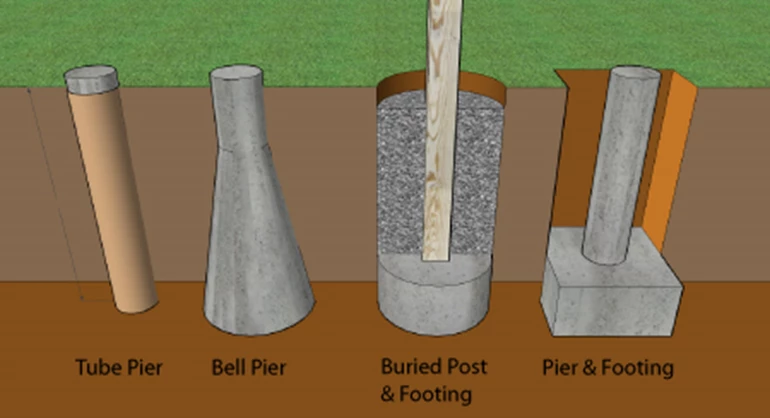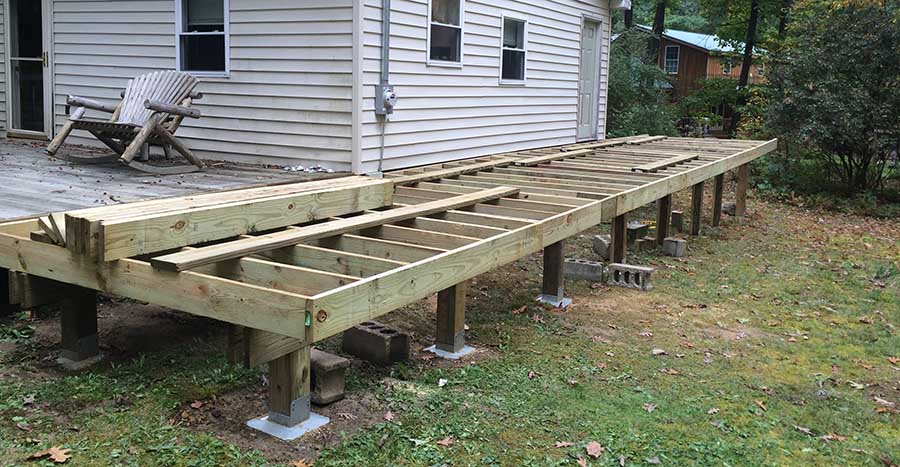Selecting the Right Deck Footings for Stability and Toughness
When it pertains to constructing a deck, one of one of the most crucial choices you will make is selecting the best footings for security and resilience. The long life and safety and security of your deck depend greatly on the sort of grounds you choose, as they supply the important support and stability to stand up to the examination of time. With a myriad of alternatives available, it can be overwhelming to establish which grounds are best matched for your specific requirements. In this conversation, we will certainly discover the different sorts of deck grounds, consider the crucial variables to consider when deciding, and dig into the pros and cons of various alternatives. By the end, you will have a more clear understanding of the choices available and be much better equipped to make a notified choice for your deck task.
Sorts Of Deck Grounds
There are several kinds of deck footings that can be utilized, each offering one-of-a-kind benefits and considerations. One common type of footing is the concrete pier footing. These grounds include a round opening loaded with concrete, which provides a solid foundation for the deck articles. Concrete pier grounds are reasonably very easy to mount and supply excellent stability, making them a prominent option for lots of deck jobs.
These footings are mounted by screwing them right into the ground, which develops a safe structure for the deck. They also permit for simple adjustment and progressing of the deck if needed.
Alternatively, some builders choose precast concrete footings. These grounds are made from durable concrete and can be found in different sizes and shapes to accommodate various deck designs. Precast concrete grounds are practical to mount and provide a secure base for the deck structure.
Ultimately, another alternative is the post-in-anchor footing system. This kind of footing includes driving a steel anchor right into the ground and attaching it to the deck article. It offers adaptability in terms of placing the deck blog posts and appropriates for decks with lightweight frameworks.
When picking the ideal type of deck ground, it is important to consider variables such as soil problems, deck tons, and local building regulations (Deck Footings). Consulting with a professional service provider or structural engineer can assist ensure the proper footing is picked for a secure and risk-free deck
Elements to Consider When Choosing Footings
When choosing the appropriate footings for a deck, it is critical to carefully think about numerous variables such as soil conditions, deck tons, and adherence to regional building regulations. These variables play a significant role in guaranteeing the stability and resilience of the deck framework.
Among the main variables to take into consideration is the dirt problems. The kind of dirt on which the deck will certainly be developed establishes the sort of footings required. Decks developed on sandy or loosened soils may require much deeper grounds to give ample assistance and stop settling. On the various other hand, decks improved clay or extensive soils may call for grounds that can fit the soil's tendency to expand and agreement.
Another important variable is the deck lots. The weight of the deck, consisting of the materials made use of and any kind of prospective live loads such as furniture or celebrations, need to be taken into account when selecting grounds. The footings must be made to birth the weight of the deck and distribute it equally to avoid any type of structural problems or failures.
Last but not least, adherence to regional building ordinance is paramount. Structure codes differ from region to area, and it is necessary to abide by the specific needs set by the neighborhood authorities. Deck Footings. These codes make sure that the deck is built securely and meets the needed standards for architectural integrity and load-bearing capability
Concrete Grounds: Disadvantages and pros

Concrete grounds offer several advantages and drawbacks when utilized as the structure for a deck. On the positive side, concrete footings offer exceptional security and toughness.
An additional benefit of concrete grounds is their versatility. They can be poured into different shapes and dimensions to suit numerous deck layouts and arrangements. Concrete grounds can be tailored to fit the certain requirements and demands of the deck structure.
However, there are additionally some disadvantages to using concrete footings. This can raise the total price of the deck project and may need specialist help.

Helical Piers Vs. Sonotubes: Which Is Better?
In thinking about the structure choices for a deck, the contrast in between helical piers and sonotubes is essential in figuring out the premium choice. Helical piers, also known as screw piles, are steel shafts with helical plates attached to them. They are twisted right into the ground making use of hydraulic equipment, providing a long lasting and steady structure for the deck. On the various other hand, sonotubes are cylindrical types made from cardboard or fiber material that are filled with concrete. They are placed in an opening explored the ground and give assistance for the deck.
When it involves stability and durability, helical piers have the top hand. The helical plates on the piers produce a strong grasp with the dirt, avoiding any activity or moving of the deck. This is look at this website specifically helpful in areas with unstable or changing soil problems. Sonotubes, on the other hand, rely only on the concrete filling up for stability, which might not use the exact same level of toughness and resistance.
In regards to setup, helical piers are relatively less complicated and faster to set up contrasted to sonotubes. The hydraulic equipment utilized to turn the piers into the ground ensures a fast and reliable procedure. Sonotubes, on the other hand, call for digging openings and putting concrete, which can be lengthy and labor-intensive.
In addition, helical piers are a more flexible choice. They can be used in different dirt conditions and can be adjusted or strengthened if required. Sonotubes, on the various other hand, might call for additional support, such as rebar, in certain dirt problems or locations with high load requirements.
Choosing the Right Footings for Your Deck's Measurements
For optimum structural stability, it is important to very carefully choose the ideal grounds that straighten with the measurements of your deck. The dimensions of your deck, including its length, width, and height, play a significant role in determining the type and size of footings required.
When selecting footings for your deck, it is important to consider the load-bearing capacity of the dirt. The weight of the deck, combined with the weight of any furnishings or individuals on it, applies a substantial pressure on the footings (Deck Footings). It is essential to choose grounds that can effectively sustain this weight without sinking or moving over time.
The shapes and size of the grounds must also be considered. Bigger decks with higher dimensions require bigger footings to offer sufficient security and support. The form of the content grounds, whether they are round or square, relies on the style and layout of the deck. In addition, the depth at which the footings are mounted ought to be established based on the frost line in your area to stop any type of heaving or shifting due to freezing temperature levels.
Verdict
In conclusion, picking the ideal deck grounds is important for ensuring security and toughness. Elements such as the type of grounds, the deck's measurements, and the pros and cons of different options ought to be thought about.
These footings consist of a cylindrical opening filled up with concrete, which supplies a strong structure for the deck blog posts. Concrete pier grounds are reasonably very easy to mount and supply excellent security, making them a preferred selection for several deck tasks.
Precast concrete grounds are hassle-free to mount and give a secure base for the deck framework.
It uses versatility in terms of positioning the deck Homepage articles and is appropriate for decks with lightweight structures.
Concrete footings offer several advantages and downsides when made use of as the foundation for a deck.